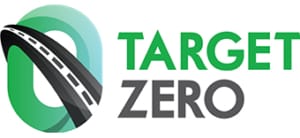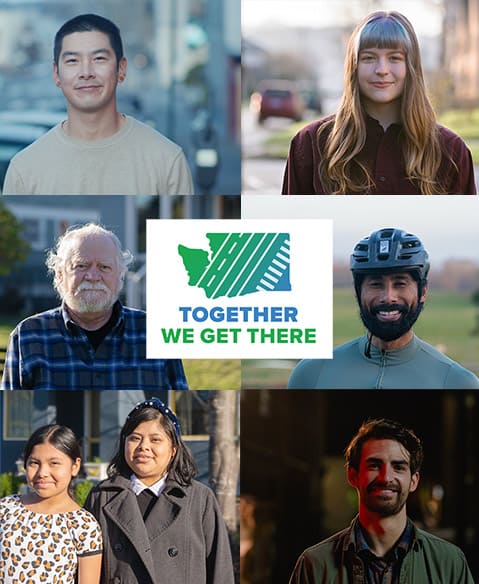“Together We Get There” Overview
Washington Traffic Safety Commission Launches ‘Together We Get There’ Campaign
New branding reflects agency’s goal of growing a positive traffic safety culture in Washington State
OLYMPIA [February 16, 2021] – Today, the Washington Traffic Safety Commission (WTSC) announces its Together We Get There brand, marking the start of the agency’s new systematic approach to improving safety on our state’s roadways. With this launch, WTSC joins a collective of forward-thinking organizations throughout the country that are using Proactive Traffic Safety Culture to usher in a new era of traffic safety communications and outreach.
Proactive Traffic Safety Culture is an approach that engages the majority of people who use the state’s roads safely in order to influence the smaller group engaging in risky behaviors. Essentially, by recognizing and reinforcing the positive safety norms that already exist in Washington, like wearing a seat belt or intervening to stop a friend from driving impaired, WTSC is creating a community that supports these safe behaviors and helps others adopt them.
“Together We Get There is built on the premise that Washington’s roadway system is a shared community. We all depend on it to connect us to the people, places, goods and services we love,” said Erica Stineman, Communications Consultant, WTSC. “We know that the majority of Washingtonians are making safe choices when they are on the road, and we want to take this opportunity to thank them for their hard work.”
The campaign was developed utilizing the Positive Culture Framework (PCF) from the Center for Health and Safety Culture at Montana State University. The framework is based on the latest research about improving health and safety and seeks to cultivate health and safety by building on shared values, beliefs, and attitudes that already exist in a culture to promote health and safety. The framework recognizes that the solutions are in the community.
“The Washington Traffic Safety Commission is a leader in the nation, and Together We Get There exemplifies their innovative approach to eliminating fatalities and serious injuries on Washington’s roadways,” said Dr. Nicholas Ward, Director of the Center for Health and Safety Culture.
The campaign will launch with a statewide advertising initiative that will include social media, and TV and radio spots in English and Spanish. WTSC has also developed a dedicated English website for Together We Get There, and Spanish website for Juntos por un camino más seguro.
Together We Get There complements WTSC’s previous brand, Target Zero, which related to the organization’s goal of zero deaths and zero traffic injuries on Washington’s roadways by 2030. While Target Zero will remain WTSC’s goal and guiding force, the organization recognized that it cannot reach this goal by speaking to the driver alone. By engaging families, workplaces, schools, community leaders, and elected officials, Together We Get There focuses on the collaborative nature of Washington’s roadways and creates a positive traffic safety culture that engages all people who use them.
Key Messages
Tone: We’re all in this together and each of us plays a role (on and off the road) to ensure we all stay safe. The majority of Washingtonians are making safe choices when they are on the road, and we want to take this opportunity to thank them for their hard work.
- Today, WTSC is launching our new Together We Get There This announcement marks the start of a new systematic approach to improving safety on our state’s roadways.
- Together We Get There reflects WTSC’s shift in approach to building a positive safety culture in Washington state.
- This new approach builds on the shared beliefs and values that already exist in a culture to improve health and safety. In terms of traffic safety, this means engaging the majority of people who use the state’s roads safely in order to influence the smaller group engaging in risky behaviors.
- Essentially, by recognizing and reinforcing the positive safety norms that already exist in Washington, like wearing a seat belt or intervening to stop a friend from driving impaired, WTSC is creating a community that supports these safe behaviors and helps others adopt them.
- Historically, traffic safety campaigns have focused on individuals who are doing the risky behaviors – from not wearing a seatbelt, to driving under the influence, speeding, etc.
- Positive traffic safety culture focuses instead on engaging the majority of safe road users to influence the behaviors of the much smaller group engaging in risky behaviors.
- Positive traffic safety behaviors go beyond the driving task. Key examples:
- Families talking about and making rules around traffic safety.
- Schools promoting traffic safety in health classes.
- Community leaders and elected officials advocating for and passing laws to reduce risky behaviors.
- Healthcare providers talking to parents about child car seats.
- Workplaces establishing policies and training for employees.
- Washington already has many indicators of strong traffic safety culture:
- Most Washingtonians agree the only acceptable number of deaths on our roadways is zero.
- Seat belt use rate (93%) is one of the best in the nation.
- Most people (78%) do not drive after drinking
- Most drivers (91%) keep their focus on the road.
- These are proactive safety behaviors, deliberate choices most of us make every day that show a commitment to a safe roadway system.




